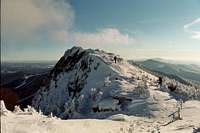|
|
List |
|---|---|
|
|
The Vermont 4000 Footers
The following is table of the summits.| Mountain | Height | Most Popular Route's YDS Rating |
| Mount Mansfield | 4393 | Class 1-2 |
| Killington Peak | 4241 | Class 1-2 |
| Camel's Hump | 4083 | Class 1-2 |
| Mount Ellen | 4083 | Class 1-2 |
| Mount Abraham | 4006 | Class 1 |
Special thanks to Nartreb for pointing this out. It should be noted that Nose on ridge on Mt Mansfield meets criteria (over 4000' with a 200' col), but due to a missing contour line by the USGS,the AMC left it off.
The 4000 Footers Overview
While the neighboring Adirondacks of New York and the White Mountains of New Hampshire the Green Mountains often don't receive much in the amount of climbing and hiking attention. But the Green Mountains are also home to five four thousand foot mountains. All of the mountains in the list have extensive views and wonderful opportunities for hiking and climbing. Three of the mountains even rise above timberline.
Many of these mountains are also home to world class ski areas. Killington, Sugarbush and Stowe all have a world renown reputation for skiing and skiing come from all over to ski on the mountains. With exception to Mount Mansfield, most of the popularity of these other mountains is from skiing and not climbing.
There is one set of trails that climb over all of these mountains. The Long Trail (it connect to the Appalachian Trail by Killington Peak) connects all of these peak and when as many of the other Green Mountains in the range.
Weather Forecast
Use this forecast if you are going to Killington Peak. alt="Click for Killington, Vermont Forecast" height=60 width=468>
alt="Click for Killington, Vermont Forecast" height=60 width=468>Use this forecast if you are going to climb Mount Mansfield.
 alt="Click for Stowe, Vermont Forecast" height=60 width=468>
alt="Click for Stowe, Vermont Forecast" height=60 width=468>Use this forecast if climbing either Camel Hump and Mount Abraham.
 alt="Click for Warren, Vermont Forecast" height=60 width=468>
alt="Click for Warren, Vermont Forecast" height=60 width=468>Weather Conditions and Gear
Weather Conditions is this region vary widely throughout the year. There is a saying in New England that if "you don't like the weather wait a minute". Any climber of the Green Mountains can vouch for that expression. The weather is unpredictable at almost all times of the year. Though the mountains here are not as extreme as Mt. Washington in New Hampshire, great care is need when climbing during the winter months. Three of the mountains are above timberline and Mount Mansfield is extensively exposed. All of these mountains are at least 2000 feet from the valley floor and have drasticlly different weather than the local towns.In summer this region is easy to dress for, especially if you taking one of the many dayhikes in the region. Only essential hiking gear is needed with sturdy shoes and a jacket. Bug repellent is a must for in very early summer it is also Black Fly season. Black flys bite with a vengance and can leave scars on your body for weeks unless you used a strong bug repellent.
Fall is the pretty time but weather is highly unpredictable here. If you are staying overnight in the region bring everything except the crampons and the snowshoes. Though it doesn't start snowing in the reason until early October, the nights in this region can get cold even in September. Bugs become less of a problem after the first frost. Bring a sturdy jacket, gloves and a hat and keep your eye on the weather condtions during this time of year. Cameras in late September and early October are AN ABOSOLUTE MUST. New England has some of pretty foilage in the United States if not the world.
Spring is the least desirable time to hike in this region. In April and May mud season from snow melt turns many of these trails to mud pits. Most of the trails are either closed for have signs discouraging hikers. However June can be a nice time to hike in this region. Temperatures are very reasonable and providing that you have bug repellent to avoid blackflys you should have little problems with weather.
Winter in this region is the most unpredictable. These mountains are hits constantly with snow. The mountains can be hit three ways.
1. By Noreasters
2. By Clippers from the west
3. Lake Effect from Lake Camplain
Be prepared for the possibility of inclement weather. Invest in crampons, trekking poles snowshoes and yaltraks if planning on hiking in winter. Depending on the hike, you might end up using all three. I have yet to here anyone needing an ice axe so would not advise bringing one. At this time of year it is key to look at the weather forecast. I never usually hike in this region unless the weather is clear or partly cloudy. If a heavy snow has fallen recently wear snowshoes. If it cold and no snow has fallen for a while that wear crampons. You can't go wrong though if you bring both.
Mountain Conditions
Check out these two links for the trail conditions in the area.Green Mountain Club
Views from the Top





nartreb - Oct 8, 2010 4:12 pm - Hasn't voted
The NoseMight want to mention below the table in the first section: the Nose on Mt Mansfield meets all the criteria (over 4000' with a 200' col), but the AMC left it off their list due to a mapmaking error by the USGS (missing contour line).
EastKing - Oct 9, 2010 12:34 am - Hasn't voted
Re: The NoseCorrection noted. Thank you very much for pointing this out.